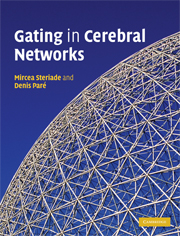Book contents
- Frontmatter
- Contents
- Preface
- Acknowledgements
- Chapter 1 Morphology and electroresponsive properties of thalamic neurons
- Chapter 2 Morphology and electroresponsive properties of neocortical cells
- Chapter 3 The amygdala
- Chapter 4 Rhinal and medial prefrontal cortices
- Chapter 5 Neuromodulation and state-dependent activities in forebrain neuronal circuits
- Chapter 6 Gating of signals in slow-wave sleep
- Chapter 7 Neuronal processes and cognitive functions in brain-active states of waking and REM sleep
- Chapter 8 Comparison of state-dependent activity patterns in the thalamocortical, hippocampal and amygdalocortical systems
- Chapter 9 Neuronal substrates of some mental disorders
- References
- Index
- Plate section
Chapter 9 - Neuronal substrates of some mental disorders
Published online by Cambridge University Press: 18 August 2009
- Frontmatter
- Contents
- Preface
- Acknowledgements
- Chapter 1 Morphology and electroresponsive properties of thalamic neurons
- Chapter 2 Morphology and electroresponsive properties of neocortical cells
- Chapter 3 The amygdala
- Chapter 4 Rhinal and medial prefrontal cortices
- Chapter 5 Neuromodulation and state-dependent activities in forebrain neuronal circuits
- Chapter 6 Gating of signals in slow-wave sleep
- Chapter 7 Neuronal processes and cognitive functions in brain-active states of waking and REM sleep
- Chapter 8 Comparison of state-dependent activity patterns in the thalamocortical, hippocampal and amygdalocortical systems
- Chapter 9 Neuronal substrates of some mental disorders
- References
- Index
- Plate section
Summary
In this chapter, we discuss mental disorders that arise from alterations in brainstem–thalamic, thalamocortical and amygdalocortical neuronal circuits. Some of these abnormal activities result from diminution or pathological increase in the number of neurons, which is reflected in their functional output and leads to substantial changes at the level of their targets.
Alterations in brainstem-thalamic and thalamocortical neuronal circuits, with emphasis on hallucinations and schizophrenia
We will first describe what is known about the role of thalamic morphological and functional modifications in the generation of autism, sleep disorders, and loss of consciousness in absence epilepsy, and will next focus on the brainstem–thalamic and basal ganglia circuits that are hypothesized to generate hallucinations in schizophrenia.
The expression of autistic disorders was ascribed by some authors to abnormal activities in some cortical areas and the thalamus. The highly attenuated dreaming in patients with autism and Asperger's syndrome (a developmental disorder regarded as equivalent to autism) was related to the ventromedial frontal cortex, which, when lesioned, gives rise to diminished dreaming. The thalamus was also implicated in autism as anatomical changes and functional alterations through this anteroom to the cerebral cortex may involve disturbances of attention and sensory gating. Thus, in autism, the thalamic volume was found to be significantly different (mainly reduced) relative to normal control subjects (Herbert et al., 2003; Tsatsanis et al., 2003); and emotion processing results in lower regional cerebral blood flow in some cortical areas and in the thalamus (Hall et al., 2003).
- Type
- Chapter
- Information
- Gating in Cerebral Networks , pp. 228 - 248Publisher: Cambridge University PressPrint publication year: 2007



